Cellophane bees (
Colletes spp) are a commonly occurring genus of bees in prairies, woodland edges and natural areas. Cellophane bees are active throughout the growing season; several species emerge in early spring.
Like most solitary, wild bees, cellophane bees nest in the ground and seek out a spot with little vegetation and open, bare soil. Many cellophane bees demonstrate a preference for nesting in sandy soils. These gentle, ground-nesting bees often construct their nests in large groupings or aggregations. The casual observer may think they are observing new ant hills, as the nests of these wild bees can look very similar to ant hills. Cellophane bees are not aggressive and they build their nests during a short window of time, often just a few weeks, so it’s easy to leave a nesting area undisturbed while they finish their nest building.
Females emerging in early spring have little forage available other than a few flowering shrubs and trees, such as willows and red maple. Like mining bees (
Andrena), some cellophane bees are oligolectic, or specialists; the females collect pollen only from a specific family of plants or, more narrowly, a particular genus of plants. If you have sandy soil or know of some nests in your landscape, maintain or provide some patches of bare ground. If you add some of their favorite forage plants, including plants sought after by specialist cellophane bees, these beautiful bees will not be able to resist visiting your garden.
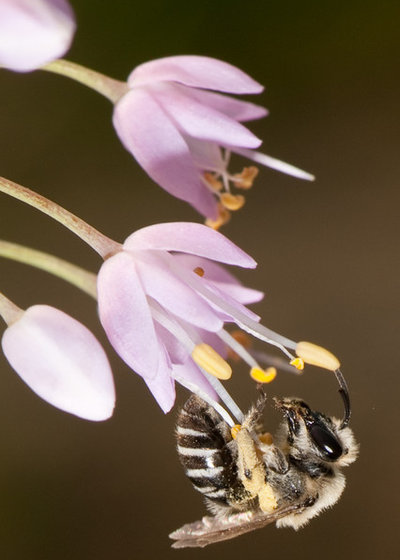
Holm Design & Consulting LLC
Family: Colletidae
Genus: Colletes Common names: Cellophane bees, polyester bees
Numbers: About 98 species in North America (north of Mexico), including 35 species east of the Mississippi, and more than 460 species worldwide
Distribution: Cellophane bees occur throughout most of the world but are absent from Indonesia, Australia and New Zealand.
Habitat: Woodland edges, gardens, meadows, prairies and old fields; many species nest in sandy soils.
Shown: A female cellophane bee on nodding onion (
Allium cernuum).
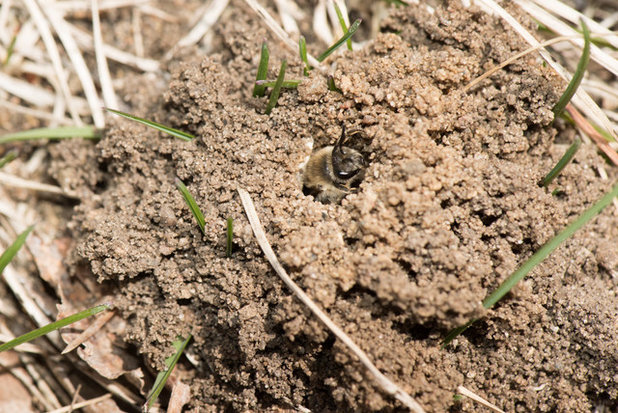
Holm Design & Consulting LLC
When to look for them: Spring is the optimum time to observe cellophane bee nests and emergence activity. Several species emerge in early spring between March and May, and their ground nests are easier to find than those of summer-emerging species because the surrounding vegetation has not yet begun to grow. You are more likely to see summer- and fall-emerging species while they are visiting flowers than to find their nests.
Like mining bees (
Andrena spp), some cellophane bees are specialists; the females seek out pollen from a narrow range of plants from a particular plant family, or, in some cases, more narrowly from a particular plant genus. There are several specializations on prairie plants including prairie clovers (
Dalea spp), lead plant (
Amorpha spp), goldenrods (
Solidago spp) and asters. Other specializations include blueberries (
Vaccinium spp) and ground cherries (
Physalis spp).
Shown: A female cellophane bee emerging from a newly excavated nest in April.
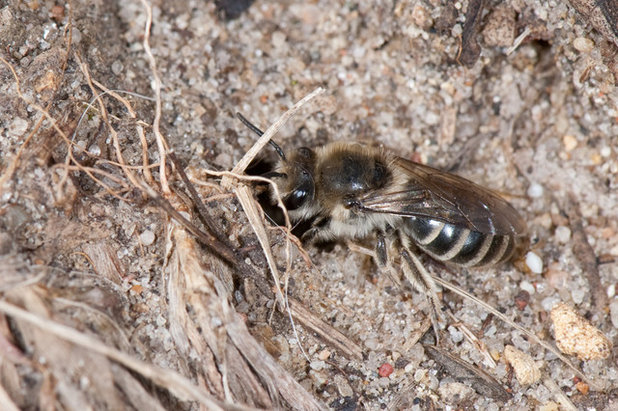
Holm Design & Consulting LLC
How They HelpCellophane bees are effective pollinators of many types of plants; they have a short tongue compared with other bee species of a similar size. This short tongue length can limit their access to nectar on complex flower forms. Collectively, cellophane bee species are active throughout the growing season.
Cellophane bees need a continuous succession of flowers in the garden and a variety of flower forms and colors. Females expend a lot of energy during nest building and provisioning, and therefore require an ongoing supply of pollen and nectar to fuel their activities, as well as to provide food for their offspring. The species that are active in early spring rely upon flowering shrubs and trees, including red maples (
Acer rubrum) and willows (
Salix spp). Summer and fall active cellophane bees typically visit more flowering perennials than trees or shrubs.
Shown: A female unequal cellophane bee (
Colletes inaequalis)
excavates her nest in open, bare sandy soil in a prairie.
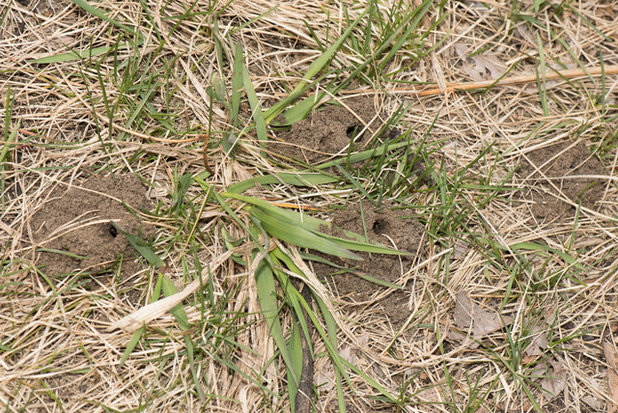
Holm Design & Consulting LLC
How to Spot Cellophane BeesAdults. Cellophane bees vary in size; the smallest species are about ¼ inch (6 millimeters) long, and the largest cellophane bees are ½ inch (12 millimeters) long. Most adults are black or dark gray with white or gold hairs on the head and thorax. The abdomen has pale bands of hairs (stripes) that are continuous from one edge of the abdomen to the other.
Males and females have tapered faces that are heart-shaped. Females collect pollen on their hind legs on hairs on their tibia and femur. Compared with many other wild bees that collect pollen on the lower portion of the hind leg, cellophane bees collect pollen noticeably higher up on the hind leg.
Babies (larvae). Larvae are grub-like and are pale yellow to cream in color. It is unlikely you will see larvae, as all cellophane bees nest below ground.
Shown: A small cluster (aggregation) of newly excavated nests.
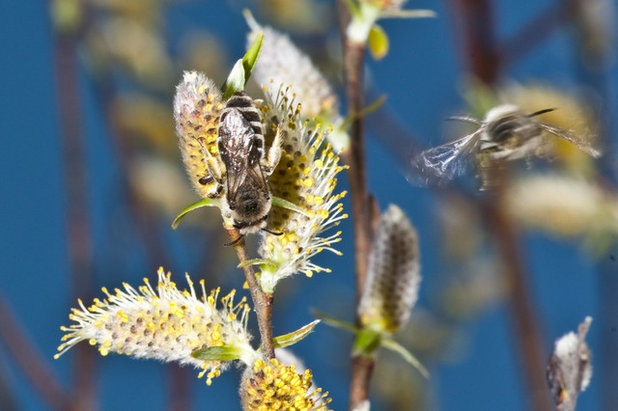
Holm Design & Consulting LLC
How to Lure ThemBesides providing a pesticide-free garden and continuous succession of flowering plants, you will need to provide a place where cellophane bees can nest. All cellophane bees nest in the ground; their preferred soil type ranges from sand to clay-loam. Many of the species that occur in prairies nest in sandy soil. Uncompacted, bare soil is ideal, but cellophane bees have been found nesting in sparsely vegetated areas.
It is important to look for bees excavating nests throughout the growing season, especially in spring, and protect the nests from any disturbance. The nests will resemble ant hills, with a nest opening and soil deposited around the opening. Nest-building activity occurs for three to four weeks; the nest is then closed by the female and all activity is complete until the offspring emerge the following year around the same time. Cellophane bee nests should be encouraged in the garden as these bees, like all solitary bees, are not aggressive.
Maintain a bee-safe yard. Do not use pesticides, especially insecticides, in the garden, particularly on flowering plants.
Shown: Willow flowers are an important source of nectar and pollen for cellophane bee species active in early spring.
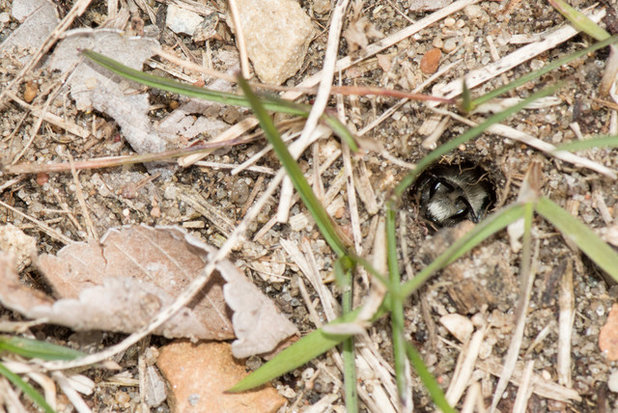
Holm Design & Consulting LLC
Forage plants for adults. Depending on the species, cellophane bee females are generalists (visiting a wide variety of plants) or specialists (visiting a narrow range of plants). Males do not actively collect pollen so will visit a wide variety of flower types for nectar. Provide both generalist and specialist plants, and select plants native to your particular area.
Sample plant list for adults:- Spring: Willows (Salix spp), red maple (Acer rubrum), wafer ash (Ptelea trifoliata), eastern redbud (Cercis canadensis), sweet cicely (Osmorhiza spp) and blueberry* (Vaccinium spp)
- Summer: Bluestar (Amsonia spp), black-eyed Susan (Rudbeckia spp), native onions (Allium spp), lead plant* (Amorpha canescens), prairie clover* (Dalea spp) and ground cherry* (Physalis spp)
- Late summer and fall: Goldenrod* (Solidago spp) and asters* (any species)
*Indicates a specialist plant
Browse native plants for your region
Shown: A male cellophane bee perched at the top of a nest emergence hole.
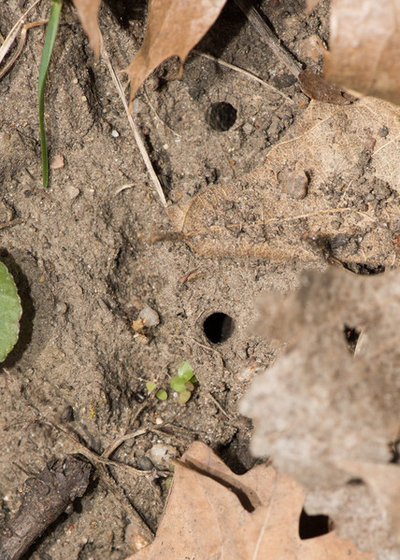
Holm Design & Consulting LLC
Life cycle. In the upper Midwest, Great Lakes and Northeast regions, cellophane bees usually have one generation per year.
Male cellophane bees often emerge from the nest first, before the females emerge. Males then fly low to the ground over the nesting area, waiting for females to emerge. When a female emerges, many males attempt to mate with her, resulting in a bee pileup. One male is successful and mating can occur for several minutes, usually on the ground or on flowers while females are foraging.
Once a female has mated with a male she looks for a nesting site to begin construction of her nest. Nests are often excavated close to where she emerged from her natal nest. Females may reuse the same nest, excavating and extending their emergence hole. Many species of cellophane bees nest in large aggregations with many nests constructed together in close proximity. Nests are commonly found in open sites in prairies, along woodland edges or in the embankment of creeks or rivers, especially in sandy soil.
Nests are excavated by the female; she loosens the soil with her teeth and by vibrating her flight muscles, then uses her mid and hind legs to push the soil upward out of the excavated hole. From the long, central shaft, short or long lateral shafts are created from which small, oval to round cells for larvae (called brood cells) are excavated. The nest architecture can vary from species to species.
Shown: A photo of emergence holes where bees come out of the ground from their natal nest.
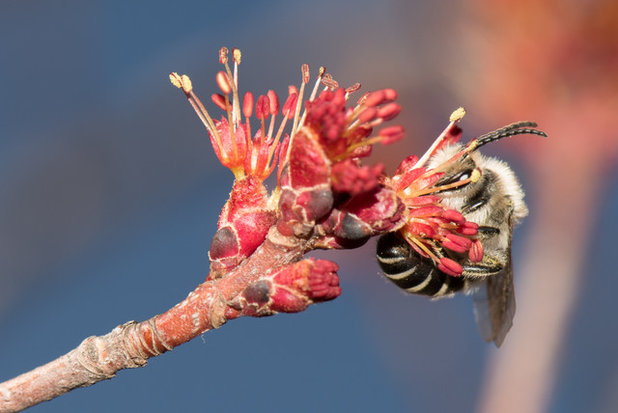
Holm Design & Consulting LLC
Cellophane bees get their common name from the material used to waterproof and line their brood cells. Females deposit a thin layer of salivary gland secretions onto the soil in the brood cell and brush it over the cell with their short, bilobed tongue. Another type of glandular secretion is applied next and is secreted from the Dufour’s gland, a gland located near the end of their abdomen. When these two bodily secretions are combined, they form a polyester or cellophane-like film over the soil. This film protects the brood cell (and developing larva) from water infiltration and food provisions from spoilage.
Females forage in the landscape and collect pollen and nectar from flowers. These floral resources are deposited into the lined brood cell. The provisions are liquidy, and when enough pollen and nectar have been collected for a given brood cell, the female lays an egg suspended from the ceiling of the brood cell. The brood cell is capped with the cellophane material, then backfilled with soil, often using soil excavated for the next brood cell in the nest.
Vernal (spring-emerging) cellophane bees overwinter as adults; summer and autumnal species typically overwinter as prepupae or pupae.
Shown: A male cellophane bee visits red maple (
Acer rubrum) flowers.
Region by region: What to Do in Your Garden This Month





